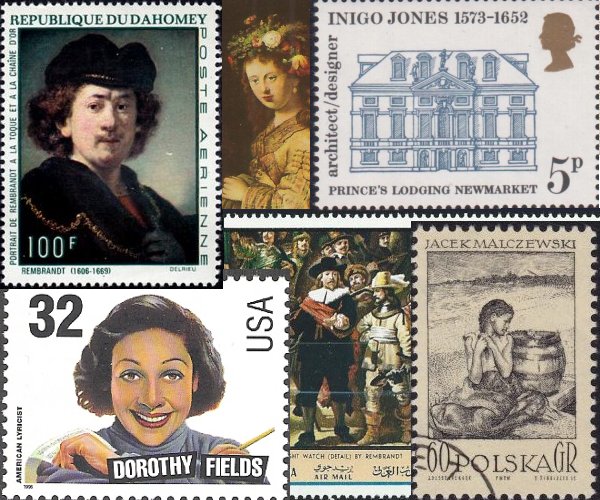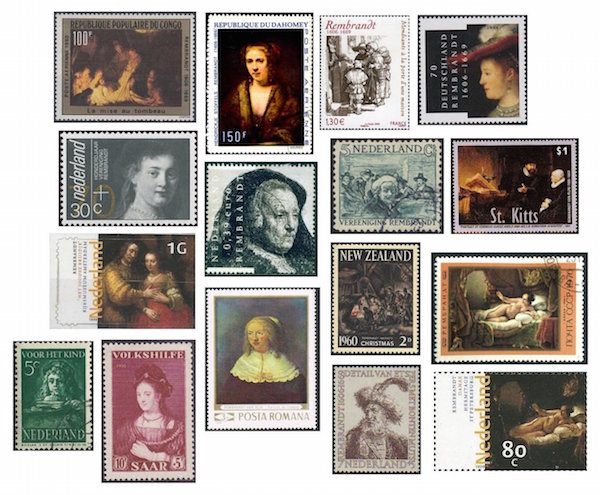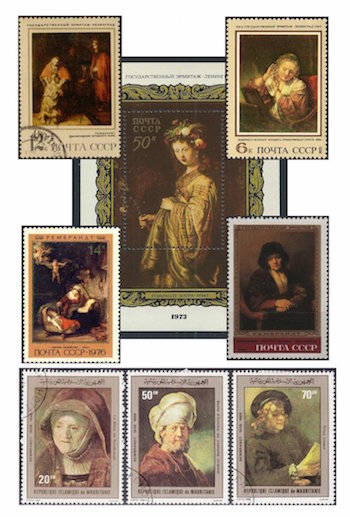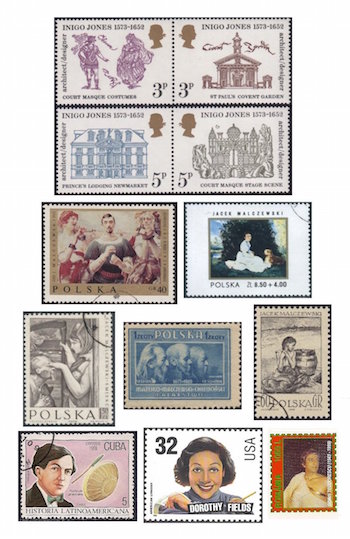The Arts on Stamps of the World — July 15
An Arts Fuse regular feature: the arts on stamps of the world.

By Doug Briscoe
Dominating the field in our presentation today is Rembrandt Harmenszoon van Rijn (15 July 1606 – 4 October 1669). I present three full collages of stamps showing his work and have enough left over for two more. For the first I’ve collected a number of (different!) self-portraits and a nice se-tenant issue of The Night Watch (1642) from one of the Arabian states (the Qu’aiti State in Hadramaut, if you must know—it’s now part of Yemen). For the second collage I put together a Russian souvenir sheet of Rembrandt’s wife Saskia van Uylenburgh in the guise of Flora (1634), surrounded (clockwise from upper left) by other Soviet stamps from various years: The Prodigal Son (1668), Young Woman Trying on Earrings (1654), Portrait of an Old Woman (1654), and The Holy Family with Angels (1645). Beneath these is a group from Mauritania: Rembrandt’s Mother (1639), Man in Oriental Costume (1635), and Titus [Rembrandt’s son] Reading (1656-7). The final collage is a miscellany of Rembrandt stamps, mostly from the Netherlands. I might just point out a few of these: at upper left the Congolese stamp is of The Entombment of Christ (1635). Next to it on a stamp from Dahomey is Portrait of Hendrickje Stoffels with a Velvet Beret (c1654). At upper right the German stamp shows a detail from Rembrandt’s Portrait of [his wife] Saskia (c1633-34). Other representations of Saskia appear in the next row and on the claret-colored stamp from the Saar. At second row right is the portrait of Cornelis Claesz. Anslo in Conversation with his Wife (1641). Third row left is The Jewish Bride (1658), and two stamps, one from the USSR, the other from the Netherlands, offer up Danaë (1643).

A highly important figure in English architecture was Inigo Jones (15 July 1573 – 21 June 1652), who also worked in stage design and was in that respect a colleague of Ben Jonson. Jones was patronized by the same Earl of Arundel who brought the engraver Wenceslaus Hollar to England. Jones accompanied the Earl to the continent, giving him the opportunity to study architecture in detail. He was named Surveyor-General of the King’s Works in 1615. As seen on the set of British stamps from 1973, Jones built St. Paul’s Church at Covent Garden (1631-37, not to be confused with St. Paul’s Cathedral, it goes without saying, though Jones did work on that building as well) and the Prince’s Lodging at Newmarket, which was demolished after the English Civil War. Other significant structures were the Queen’s House at Greenwich (1616-19 and 1630-35), the Banqueting House at Whitehall (1619-22), and Wilton House in Wiltshire. A portrait of Inigo Jones by Anthony Van Dyck is in London’s National Portrait Gallery.

One of Poland’s favorite painters is Jacek Malczewski (mahl-TCHEF-ski; 15 July 1854 – 8 October 1929). He studied with the even more beloved Jan Matejko (both men, along with Jósef Chełmoński, are grouped together on a stamp from 1947). In addition to frequent travels to the great art centers of Europe, Paris, Munich and Vienna, Malczewski made repeat visits to Italy, Greece, and Turkey and even participated in some archaeological digs. He subsequently taught at and became director of the Kraków Academy. His themes tended to be Polish history and folklore, the Bible and mythology, and nature scenes, and he painted a number of self-portraits, often in historical costume, with a touch of self-mockery. He was related on his mother’s side to the composer Karol Szymanowski. Our first Malczewski stamps show The Polish Hamlet; a Portrait of Aleksander Wielopolski (1903) and Portrait of a Young Lady. On either side of the triple portrait (Malczewski is in the middle) are monochrome reproductions of Death (1902) and The Poisoned Well (1906).

Enrique Soro (1884 – 3 [or 2] December 1954) was one of the first Chilean symphonists. (One online source states that his Romantic Symphony in A, composed 1920-21, was the only symphony by a Chilean until 1948.) Like other gifted South American composers of his day, Soro, a child prodigy, received a scholarship to study in Italy at the Milan Conservatory, winning the Grand Prize for composition in 1904. His work as a pianist, improviser, and composer was admired by the likes of Saint-Saëns and Mascagni. On his return to Chile he taught at the National Conservatory, of which in 1907 he became director. His music was written in the cosmopolitan romantic tradition, but in a few instances also made use of native elements, as in his Three Symphonic Preludes (1936) and Three Chilean Airs (1942). The stamp comes from a Cuban set honoring Latin American composers.

One of the first successful female lyricists on Tin Pan Alley was Dorothy Fields (July 15, 1905 – March 28, 1974), who worked with such luminaries as Jerome Kern, Irving Berlin, and Cole Porter. With Kern she won the 1936 Best Original Song Oscar for “The Way You Look Tonight” from Swing Time. She also took the 1959 Tony Award for Best Musical for Redhead (music by Albert Hague). Fields and her brother Herbert co-wrote the book for Annie Get Your Gun (1946). Over the course of her career she wrote or collaborated on the lyrics/books for 400 songs, 15 musicals, and 26 movies.
There is also a postal card (I show just the corner) for the Romanian tenor Dorin Teodorescu (July 15, 1943 – March 26, 1999), director of the Bucharest Operetta and professor of voice at the Bucharest University of Music.
It would be nice someday to see a stamp for Iris Murdoch (15 July 1919 – 8 February 1999).
A graduate of the University of Massachusetts with a B.A. in English, Doug Briscoe worked in Boston classical music radio, at WCRB, WGBH, and WBUR, for about 25 years, beginning in 1977. He has the curious distinction of having succeeded Robert J. Lurtsema twice, first as host of WGBH’s weekday morning classical music program in 1993, then as host of the weekend program when Robert J.’s health failed in 2000. Doug also wrote liner notes for several of the late Gunther Schuller’s GM Recordings releases as well as program notes for the Boston Classical Orchestra. For the past few years he’s been posting a Facebook “blog” of classical music on stamps of the world, which has now been expanded to encompass all the arts for The Arts Fuse.

